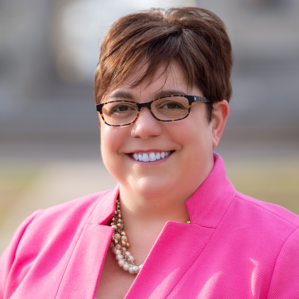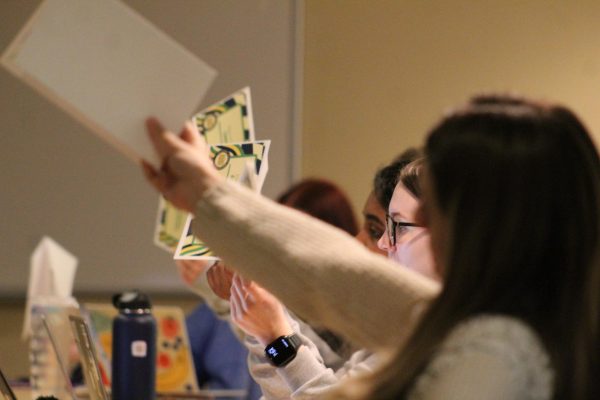Professors receive GLCA award
Aimee Knupsky, associate professor and chair of the psychology department at Allegheny College, and M. Soledad Caballero, associate professor of English, were selected this past May to receive a three-year grant from the Great Lakes Colleges Association for their work in promoting interdisciplinary studies at Allegheny and on campuses belonging to the GLCA.
The grant, known as an Expanding Collaborative Initiative, provides $113,000 to Knupsky and Caballero to recruit, organize and lead interdisciplinary teams from different schools in the GLCA. Each team consists of two faculty from different academic disciplines who will use their portion of the funding to team-teach an interdisciplinary class at their respective campus.
Currently, four such teams exist, but Knupsky and Caballero hope to expand the initiative to include four more teams, totaling sixteen faculty members from eight different schools.
“We’re working with teams from Denison, Kenyon and Ohio Wesleyan,” said Knupsky. “Our goal across the next three years is to find at least one new team from each school that’s going to propose an interdisciplinary course across the sciences and humanities.”
Knupsky and Caballero currently team-teach an interdisciplinary course, called the Cognitive Humanities. The course examines emotion through both a neuro-psychological lens and a literary one. Students examine not only how emotion is regulated and expressed through cognitive pathways, but how it is represented in theater and literature.
The inception of the course followed a previous grant being awarded to Knupsky and Caballero in 2013, called the New Directions Initiative.
“The NDI was a smaller scale for tenured professors who want to jumpstart new research programs outside of their official research expertise,” said Caballero. “Professor Knupsky and I applied as a team for this NDI grant. And that’s how we started the first iteration of the Cognitive Humanities class. We realized we wanted to make connections between the arts and the humanities.”
In addition to promoting interdisciplinary research within their individual campuses, faculty teams are encouraged to visit other campuses, both to speak about their own experiences in interdisciplinary teaching and to learn from the experiences of their colleagues.
“This semester we’ve been doing a series of exchanges to each other’s campuses,” Knupsky said. “Professor Caballero and I presented our work at Kenyon, and our colleagues at Kenyon came here to talk about their course in philosophy and neuroscience.”
Over the three-year course of the grant, Knupsky and Caballero will act as lead facilitators for the other team mentors, assisting in designing courses and collecting data on the relative successes of those courses in stimulating interdisciplinary learning.
“Next summer we’re going to get together and help the teams that just signed on with how to teach their classes,” said Caballero. “This allows for all sixteen of the faculty to come up with the best practices for teaching interdisciplinary classes: assessment for the courses, goals and a game plan.”
Knupsky and Caballero are spearheading their initiative at a time of increased discourse surrounding the function of interdisciplinarity in the Allegheny curriculum.
Eric Boynton, associate professor and department chair of philosophy and religious studies, envisions a hypothetical, problem solving-based approach for learning that would work to dissolve boundaries between discrete academic disciplines.
The approach, called “problem-based inquiry,” would draw students with skills from different academic backgrounds to attack a problem that could not be addressed or disentangled by one set of skills or repertoire of knowledge alone.
“Right now there is a structure of majors and minors programs,” said Boynton. “It has the solidity and character of an anchor point in the curriculum. But it could be more than that: something a little more free-form and nimble.”
Both Boynton and Patrick Jackson, visiting assistant professor of history, believe that interdisciplinary learning and research are experiences that students should encounter in their curriculum.
“Each discipline has its own methodologies,” said Jackson. “We want to have people bring the skills that are developed in each discipline to bear in a way that’s not limited by methodology of each discipline.”
The trouble, as articulated by Knupsky and Caballero, is that when students want to investigate a potential research problem that exists beyond the scope of a single department, they often find that they must conform their approach to the boundaries set by disciplinary precedent.
“Different frameworks of different departments for senior research projects become stumbling blocks for students looking to perform interdisciplinary research, because we don’t really provide opportunities for students who want to do this thinking in the curriculum at the present,” said Caballero.
Knupsky and Caballero hope that their course, Cognitive Humanities, might act as a framework for future approaches to interdisciplinary research queries.
“We are trying to put together a structure that might be used by students at Allegheny who are either completing double-majors or who might be interested in doing collaborative, interdisciplinary work,” Knupsky said.
Boynton and Jackson both pointed out that the push for increased interdisciplinary thought on campus should not be interpreted as an invective against concrete disciplinary thought or knowledge.
“Another way of thinking about interdisciplinarity is that it is like the antioxidant of any discipline,” said Jackson. “It scrubs and opens up, decalcifies and limbers up disciplinary thinking. It’s by no means a criticism or disparaging of disciplinary knowledge. But it is a recognition that liberal arts colleges are training people to be supple thinkers, not necessarily for getting a job in a specific industry.”
But interdisciplinary thought, as stressed by Boynton and Jackson, is not absent from Allegheny’s campus. As Boynton points out, the FS program was designed to facilitate interdisciplinary thought, both on the part of students and professors, the latter of whom are usually expected to teach outside of their field of research in an FS topic.
“I have appointments both in history and in religious studies, and my FS class involves philosophy and literature,” said Jackson. “These are topics that I’m interested in, and the FS program gives me a space to explore topics that I’d missed studying professionally.”
Boynton, who is the director of interdisciplinary studies at Allegheny, also has experience integrating knowledge and analytical models in the humanities with those in the hard sciences to tackle problems in the classroom.
“I’ve team-taught with [Provost] Ron Cole, when he was with the geology department, in travel courses in Turkey,” Boynton said. “The courses linked up the humanities and geology around the ways in which specific places, and their river systems and geological processes mattered to the ways that people thought about themselves in that environment.”
In other words, Boynton and Cole challenged students to apply geological and cultural data and analyses to solve historical queries. This collaboration is of the exact kind that Caballero and Knupsky hope to foster amongst their own students.
“I think we have an artificial cultural divide between what we call science and what we call art and the humanities,” said Caballero. “So the endgame for me is to bring back those conversations [between divisions] and make them much more integrated, in the curriculum and amongst faculty.”
Boynton and Jackson both stress that the value of interdisciplinarity is not fully realized until students leave the academic world and enter a constantly-changing professional one.
“Most students who graduate from here are not going to work directly in the field they’ve studied,” said Boynton. “So there’s a way in which we have to prepare people through the discipline to be able to open up to be able to solve whatever problems they face in their job and in their life.”
Thinking beyond a discipline will not just help students with their professional lives, assert Boynton and Jackson. It will help students grow into intellectually robust and morally sound adults as well.
“Most of the problems of life don’t submit themselves to disciplinary solutions, including the problem of how to find and keep meaningful work,” said Jackson. “There’s also the question of: How are you going to deal with your personal life? How are you going to make and keep friends? How are you going to decide how to use your money or what to spend it on? How to be a consumer? How to be a citizen? None of those things are easily answerable from one particular disciplinary perspective.”
As a literary scholar of the Romantic period, Caballero knows that interdisciplinary thought has strong historical precedence among writers, philosophers, scientists and artists.
“In the period I study, there were no divisions,” said Caballero. “I study the British Romantics. And the poets and writers of that time hung out with who we now call scientists, but who were called ‘naturalists’ or ‘philosophers’ back then.”
The pursuit of interdisciplinary thought, according to Jackson, should not necessarily involve a tourism of all topics one might find aesthetically satisfying. Instead, the function of such an education should be preparedness for a kind of malleability of mind.
“We’re not saying that you need to become a dilettante, a dabbler in all these things,” said Jackson. “What we want is for you to have the wherewithal or the capacity to take that training and then map it in different directions. The world is not fixed, so we want to train you to have the capacity to find yourself in that world.”








